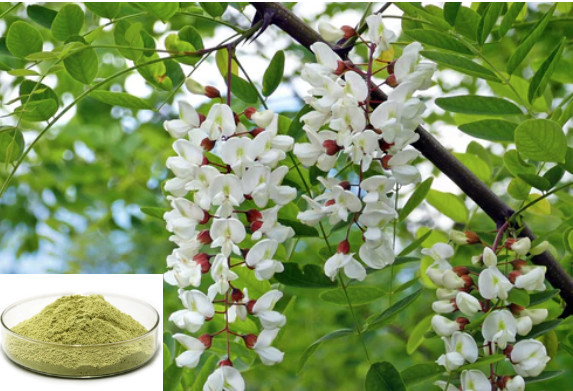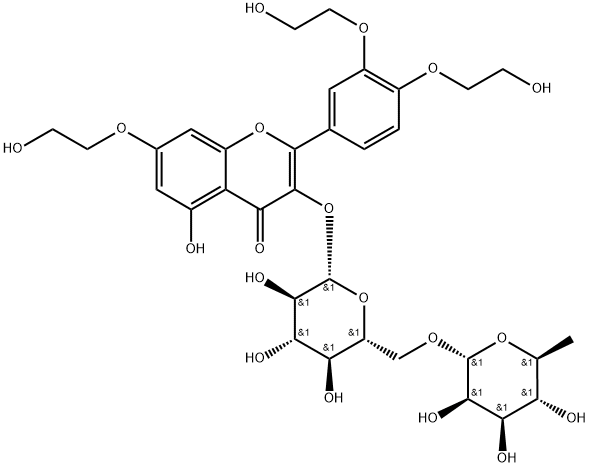What are the uses of Troxerutin?
Introduction
Troxerutin (TRX), also known as vitamin P4, is a naturally occurring flavonoid derived from rutin (3',4',7'-Tris[O-(2- hydroxyethyl)] rutin) that can be found in tea, coffee, cereals, fruits, and vegetables.
Chemical property

TRX is a flavonol obtained from rutoside, a natural flavonoid, which is hydroxylated at the 3', 4' and 7th positions in the rutin structure. TRX is a yellow powder that is comfortably soluble in water. TRX should be stored at 2-8°C and protected from air and light to avoid degradation. TRX belongs to the class of organic compounds identified as flavonoid-3-o-glycosides. These phenolic compounds include a flavonoid moiety that is O-glycosidically linked to a carbohydrate moiety at the C3 position. TRX constitutes approximately 80% of tris rutin as the main compound, whereas bis rutin, tetrakis rutin, and mono rutin occur to a negligible extent. A study indicated that synthesizing troxerutin-acylated derivatives significantly increases the bioavailability and antioxidant activities of TXR in cells by improving its lipophilicity. Indeed, acylation of TRX by P. aeruginosa and P. stutzeri allows obtaining two products, troxerutin monoester and troxerutin diester, which showed better bioavailability, absorption and antioxidant activities than native TRX.
Benefits
Troxerutin exerts multiple biological functions, including antioxidant, anti-inflammatory, nephroprotective, antithrombotic, antidiabetic, and neuroprotective effects. Following ingestion, flavonoids are partially digested by the microbiome, which facilitates the absorption by small or large bowel. As a derivative of the naturally occurring bioflavonoid rutin, it has been suggested to inhibit red cell and platelet aggregation, improve erythrocyte deformability, and, thus, improve plasma viscosity and retinal microcirculation.
Biological activity
Troxerutin exerts its antioxidant functions through direct free radical scavenging activity and by enhancing the activity of glutathione and antioxidant enzymes, such as superoxide dismutase, catalase, and glutathione peroxidase. Through its antioxidant activities, troxerutin might preserve epithelial cells, fibroblasts, and lymphocytes from oxidative stress-induced apoptosis.
Troxerutin was found to protect against gentamycin-induced acute kidney injury in rats through the downregulation of inflammatory cytokines (IL-10, TNF-α, and IL-6), the reduction of apoptotic cell death, and the induction of renal tissue regenerative capacity by acting on p38 mitogen-activated protein kinase signalling.
In addition, Troxerutin protects the hippocampus against amyloid-beta-induced oxidative stress and apoptosis by reducing the acetylcholinesterase activity and oxidative stress. In a rat model of traumatic brain injury, troxerutin exerted multiple protective effects through the regulation of endothelial NOS activity. Moreover, troxerutin demonstrated anxiolytic- and antidepressant-like activities in rodents.
References
[1] Mohammad Zamanian. “The Protective Roles and Molecular Mechanisms of Troxerutin (Vitamin P4) for the Treatment of Chronic Diseases: A Mechanistic Review.” Current Neuropharmacology 19 1 (2021): 97–110.
[2] MD, Matteo Tosato et al. “Nutraceuticals and Dietary Supplements for Older Adults with Long COVID-19.” Clinics in Geriatric Medicine 38 3 (2022): Pages 565-591.
);You may like
See also
Lastest Price from Troxerutin manufacturers

US $0.00-0.00/Kg/Drum2024-09-18
- CAS:
- 7085-55-4
- Min. Order:
- 1KG
- Purity:
- 99%min; EP
- Supply Ability:
- 500KG

US $15.00/kg2024-09-11
- CAS:
- 7085-55-4
- Min. Order:
- 1kg
- Purity:
- 95%
- Supply Ability:
- 20 tons


